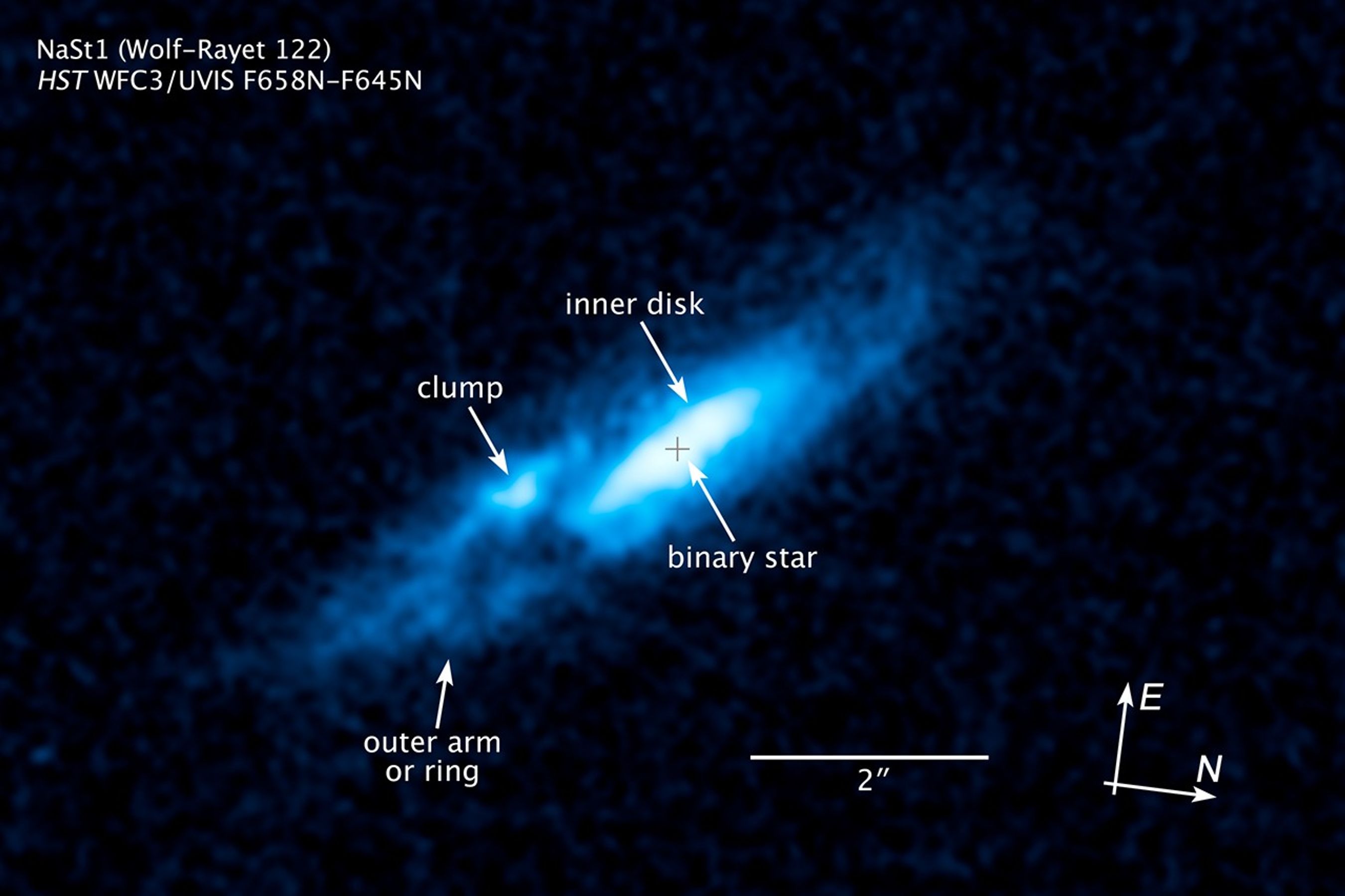1 min read
Hubble Spies Vast Gas Disk around Unique Massive Star

This visible-light image taken by NASA's Hubble Space Telescope reveals a pancake-shaped disk of gas around an extremely bright star in our Milky Way galaxy. The disk glows brightly in the light of ionized nitrogen.
The central star is nicknamed "Nasty 1," derived from its catalog name of NaSt1. Nasty 1 is thought to be a Wolf-Rayet star, a massive, rapidly evolving star weighing well over 10 times the mass of our sun. The star is losing its hydrogen-filled outer layers quickly, exposing its super-hot and extremely bright helium-burning core.
Nasty 1 is thought to have a companion, and gravitational interactions between them may have created the gas disk. Both stars are heavily obscured by gas and dust in the disk. Hubble observations suggest that as Nasty 1 sheds its weight, some of the mass is falling onto a companion star and some is leaking into space, forming the disk. The vast structure is nearly 2 trillion miles wide. The disk is clumpy because astronomers think the outbursts occur sporadically. The knot at left of center is an unusually bright clump of gas. The image is tinted blue to bring out details in the disk.
Astronomers were surprised to find the disk-like structure, which has never been seen before around a Wolf-Rayet star in our galaxy. The star may represent a brief transitory stage in the evolution of massive stars.
The Nasty 1 system may be as close as 3,000 light-years from Earth.
The observations were taken in April 2013 with the Wide Field Camera 3.
About the Object
- R.A. PositionR.A. PositionRight ascension – analogous to longitude – is one component of an object's position.18h 52m 17.55s
- Dec. PositionDec. PositionDeclination – analogous to latitude – is one component of an object's position.00° 59' 44.28"
- ConstellationConstellationOne of 88 recognized regions of the celestial sphere in which the object appears.Aquila
- DistanceDistanceThe physical distance from Earth to the astronomical object. Distances within our solar system are usually measured in Astronomical Units (AU). Distances between stars are usually measured in light-years. Interstellar distances can also be measured in parsecs.Between 3,300 - 9,800 light-years (1 - 3 kpc) away
About the Data
- Data DescriptionData DescriptionProposal: A description of the observations, their scientific justification, and the links to the data available in the science archive.
Science Team: The astronomers who planned the observations and analyzed the data. "PI" refers to the Principal Investigator.Data of WR 122 were obtained from the HST proposal 13034: J. Mauerhan (University of California, Berkeley), N. Smith (Steward Observatory/University of Arizona), and S. Van Dyk (IPAC/Caltech). The science team comprises: J. Mauerhan (University of California, Berkeley), N. Smith (Steward Observatory/University of Arizona), S. Van Dyk (IPAC/Caltech), K. Morzinski, L. Close, P. Hinz, and J. Males (Steward Observatory/University of Arizona), and T. Rodigas (Carnegie Institute of Washington). - InstrumentInstrumentThe science instrument used to produce the data.HST>WFC3/UVIS
- Exposure DatesExposure DatesThe date(s) that the telescope made its observations and the total exposure time.April 27, 2013
- FiltersFiltersThe camera filters that were used in the science observations.F645N (Continuum) and F658N ([N II])
- Object NameObject NameA name or catalog number that astronomers use to identify an astronomical object.NaSt1, Wolf-Rayet 122, WR 122
- Object DescriptionObject DescriptionThe type of astronomical object.Emission-line Star with Nebula
- Release DateMay 21, 2015
- Science ReleaseHubble Observes One-of-a-Kind Star Nicknamed ‘Nasty’
- Credit

Related Images & Videos

Mass Star and Smaller Companion Create Vast Gas Disk (Artist's Illustration)
This artist's illustration reveals a vast disk of gas surrounding a massive, bright Wolf-Rayet star (shown at center). A close companion star is pulling gas from the Wolf-Rayet, shown by the bridge of bright material connecting the two stars. This act of celestial cannibalism...
Share
Details
Claire Andreoli
NASA’s Goddard Space Flight Center
Greenbelt, Maryland
claire.andreoli@nasa.gov





























